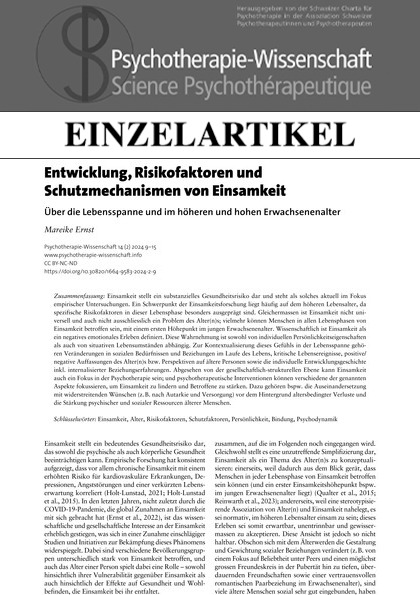Development, risk factors and protective mechanisms of loneliness
Across the lifespan and in late and old adulthood
DOI:
https://doi.org/10.30820/1664-9583-2024-2-9Keywords:
loneliness, age, risk factors, protective factors, personality, attachment, psychodynamicsAbstract
Loneliness represents a substantial health risk and as such is currently the focus of empirical studies. Loneliness research often focuses on older age, as specific risk factors are particularly pronounced in this phase of life. At the same time, loneliness is not universal, nor is it exclusively a problem of old age; rather, people can be affected by loneliness at all stages of life, with an initial peak in young adulthood. Scientifically, loneliness is defined as a negative emotional experience. This perception is dependent on both individual personality traits and situational life circumstances. Changes in social needs and relationships over the course of life, critical life events, positive/negative perceptions of age(ing) and perspectives on older people as well as the individual’s developmental history, including internalized relationship experiences, help to contextualize this feeling over the lifespan. Apart from the socio-structural level, loneliness can also be a focus in psychotherapy; and psychotherapeutic interventions can focus on various of the aspects mentioned in order to alleviate loneliness and strengthen those affected. This includes, for example, dealing with conflicting desires (e. g. for self-sufficiency and care) against the background of age-related losses and strengthening the psychological and social resources of older people.
Downloads
How to Cite
Ernst, M. (2024). Development, risk factors and protective mechanisms of loneliness: Across the lifespan and in late and old adulthood. Psychotherapie-Wissenschaft, 14(2), 9–15. https://doi.org/10.30820/1664-9583-2024-2-9
Issue
Section
Special Issue
License

This work is licensed under a Creative Commons Attribution-NonCommercial-NoDerivatives 3.0 Unported License.
This journal provides open access to its content in accordance with the basic premise that the free public availability of research benefits the exchange of knowledge throughout the world.
Authors wishing to publish in this journal agree to the following:
- The author/s retain/s the copyrights and consent/s to initial publication of the work in the journal under a Creative Commons Attribution licence, which allows third parties to use the work by citing the name/s of the author/s and this journal as initial publisher (in accordance with the Creative Commons Attribution-NonCommercial-NoDerivs 3.0 DE-Licence).
- The author/s can enter into additional contracts for the non-exclusive distribution (e.g. publish in a collection or book) of the version published in the journal, if the journal is cited as initial publisher.


